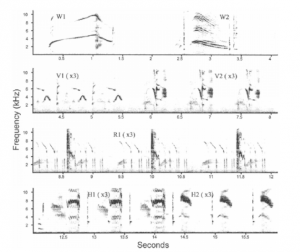In the European Starling both sexes are able to produce song. Although the male does the majority of the singing, it is not uncommon to hear females sing, though mainly out-of-season (Pavlova, 2005, p.560). Songs in male birds are thought to serve mainly two functions; territorial defense or attraction or stimulation of a mate or mates (Mountjoy,1997, p. 665). Although the primary function of song seems to be female attraction and/or stimulation, starling song may also have an component specifically tailored to competition within the same sex. It was Feare (1984) who suggested that starling song may function in territorial defence (p.250). Whilst “starlings make an impressive range of sounds, including clear whistles, liquid warbling, harsh chattering, high pitched trills, rattles, and strident screams, in addition to mimicry of other sounds (Cabe 1993)” there are two major categories. According to Adret-Hausberger and Jenkins (1988),these two categories of song are: ‘whistled’ and ‘warbling’ songs. Whistled songs or whistles are short, loud and stereotyped songs (see Fig. W1), while warbling song is organized in long and complex sequences of notes (see Fig. R1) (pg 142).
(Mountjoy, 1997)
Adret -Hausberger and Jenkins proposed in their article that whistled songs or whistles are primarily used in male-male interactions, while the warbling song functions primarily in male-female interactions.
In general, the male engages in bouts of song lasting for a minute or more. Each of bout typically includes four varieties of song type- whistles, warbles, rattles and high frequency phases- which follow each other in a regular order without pause. According to Hausberger “the bout starts with a series of pure-tone whistles followed by the main part of the song, a number of variable sequences that often incorporate song mimicked from other species of bird and various naturally occurring or man-made noises(1988, p.152).” Each section is repeated a number of times. Whilst the song does not allow for a great deal of variance, from the variance that is allowed, the common starling is able to attain his own repertoire of unique sounding songs. This repertoire usually consists of around 30 variable song types with unique high pitched sounds as the end. Males continue to sing in non-breeding seasons due to the association between the act of singing and the reward they get for doing so successfully (Riter 2014). Female song although less complex is quite interesting. The female sings bouts of more than 30 seconds of uninterrupted song. In general some females all the same sections that male do -whistle, warbles, rattles and high frequency phases (Pavlove, 2005, p.560) . Although a significantly lower proportion of females sing all four sections when compared to males, female song has more vocal mimicry in it when compared to the male song (Pavlova, 2005, p. 568).
Here is a recording of song in common starling:
https://www.youtube.com/watch?v=gUwv32te6TE
Starling song is not innate, but learned and cemented over the course of life. They start out with a subsong which is variable, but still somewhat reminiscent of their future song. As their age progresses, they learn their song from males around them. What’s interesting about this is that wild males have a larger repertoire than captive males, so clearly the environment plays a part on song learning. At around 10 months, the color of the male’s bill changes. Along with this change, the bird has developed his whistle song, which suggests that there may be some kind of hormonal trigger (Cabe 1993). A hormone that has a great affect on song production is testosterone. If introduced in a female bird of any species it can cause her to sing. What’s interesting is the effect that this hormone has on different parts of a starling’s brain. In a study done by Cordes, Stevenson, and Riters (2014), they found that it has a different effect in three different areas. One may stimulate motivation, another song quality, and yet another stimulates vocalizations (Cordes, Stevenson, and Riters 2014). Testosterone does not work alone, as there are other hormones that influence song based on a bird’s motivation (Cordes 2015). European starlings are open ended learners, and will continue learning elements of different songs throughout their life.
As well as their own song, starlings can learn the songs of other species, and even non-living things, depending on their environment.The larger the number of songs and sounds they are able to imitate, the more attractive a bird is to potential mates. There are no recorded dialects of European starlings in North America, however in its places of origin like Africa and Europe, dialects vary slightly by region.
References:
Adret-Hausberger, M., & Jenkins, P. (1988, December). Complex organization of the warbling song in the European starling Sturnus vulgaris. Retrieved May 3, 2015, fromhttp://www.jstor.org/stable/4534727
Chaiken, M., Böhner, J., & Marler, P. (1994, March). Repertoire Turnover and the Timing of Song Acquisition in European Starlings. Retrieved May 3, 2015, fromhttp://www.jstor.org/stable/4535163
Cordes, M., Stevenson, S., Driessen, T., Eisinger, B., & Riters, L. (2015). Sexually-motivated song is predicted by androgen-and opioid-related gene expression in the medial preoptic nucleus of male European starlings (Sturnus vulgaris). Behavioural Brain Research, 12-20. Retrieved May 3, 2015.
Cordes, M., Stevenson, S., & Riters, L. (2014). Status-appropriate singing behavior, testosterone and androgen receptor immunolabeling in male European starlings (Sturnus vulgaris). Hormones and Behavior, 329-339. Retrieved May 3, 2015.
Feare, CJ. (1984). The starling. – Oxford University Press, Oxford.
Mountjoy, D., & Lemon, R. (1997, August). Male Song Complexity and Parental Care in the European Starling. Retrieved May 3, 2015, from http://www.jstor.org/stable/4535464
Pavlova, D., Pinxten, R., & Eens, M. (2005, August). Female Song in European Starlings: Sex Differences, Complexity, and Composition. Retrieved May 3, 2015, from http://www.jstor.org/stable/4096541
Riters, L. (n.d.). Reward Associated with Singing Behavior Correlates with Opioid-RelatedGene Expression in the Medial Preoptic Nucleus in Male European Starlings. PloS One, 9(12). Retrieved May 3, 2015.


is every bird has their own songs?